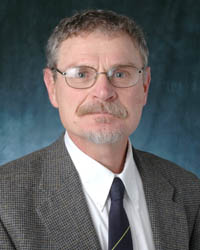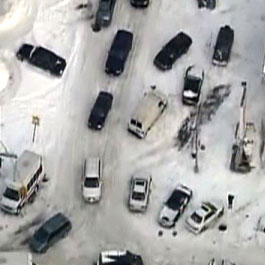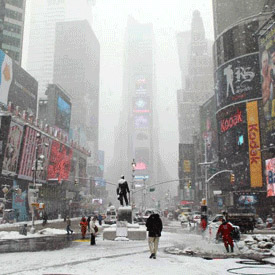Ogmius exchangeIntroduction to Ogmius ExchangeThis issue of Ogmius features an article by Center for Science and Technology Policy Research (“Policy Center”) director William (Bill) Travis about the conundrum faced by city managers trying to prepare for infrequent but severe snowstorms. Bill Travis is also an Associate Professor of Geography at the University of Colorado, Boulder. His teaching and research focus on human behavior in the environment, including studies of the human dimensions of climate change, land use and the interaction of people and ecosystems. His current projects focus on the theme of potential social response to extreme climate change, including warning systems, the most transformative and difficult adaptive choices, and geo-engineering responses in the face of a “climate emergency.” Comments welcome! info@sciencepolicy.colorado.edu |
 |
Snowmageddon Policy and Politics
|
 |
After a December snowstorm brought the city to a standstill, New Yorkers were not shy in criticizing officials, especially the mayor, for the slow recovery, and, alas, some were equally quick with the jokes when city officials appeared over-prepared for the next threatening storm, which fizzled. Ungrateful citizens, who felt that snowplows were rather too scarce in the blizzard two weeks earlier, poked the city for fielding “one truck for every flake” for less than an inch. At least New York has the equipment. When Atlanta had its own snowpocalypse in mid-January, that city’s handful of sanding and plowing trucks, which spend many a winter unused, also couldn’t cope. The mayor apologized, but in response to reporters’ persistent questions about whether the city had properly prepared in advance given weather forecasts of a serious storm, the mayor put his decision-making quandary bluntly: the city, he said, “shouldn’t purchase mass amounts of equipment that we may never use again”. He also noted that just before the storm he had doubled the city’s available equipment, from 10 to 20 plows or sanders. The unusually deep and persistent snowfall for a southern metropolis had Atlanta out-bidding other municipalities to hire more equipment. But it wasn’t enough. |
 |
The dilemma of maintaining adaptive capacity that rarely gets utilized is a very old one, faced by electric utilities and many other service providers. It is the natural condition of all emergency response systems which are designed to operate only in rare circumstances, and are often neglected during routine times. The pendulum from being caught unprepared, to over-preparedness, is the stuff of late-night talk show jokes, and also the history of hazards and disaster planning. Extreme events demand preparedness, but also occur infrequently enough that the long “waiting time” between them simply erodes preparedness. Atlanta’s mayor is right: a big investment in snowplowing equipment is simply not justified by the city’s climate, but that logic won’t help if, as he rolls the dice next winter, nature produces another paralyzing coat of ice and snow. Many a mayoral career was cut short by unplowed snow. A similar policy conundrum faces British transport managers who also took a public shellacking this year as a winter storm laid down persistent snow and ice. All these snowstorms were perhaps one in 20- to 25-year events, an awkward period ill-suited to cycles of capital equipment and emergency preparedness. And all the affected bureaucracies are now considering greater investments in snow-fighting so that planes, trains and cars can go on through the storm. But it is telling that Atlanta doubled its snow-fighting fleet ahead of the storm, a 100% increase, and eventually, by calling in contractors from all over, put over 58 pieces of equipment to the task, a five-fold bump that still left the residents dissatisfied. Just how much snow-fighting capacity would they need? Early in natural hazards research a group of economists, geographers, engineers, sociologists and psychologists grappled with the conundrum of preparing for rare events, of decision-making and investment under uncertainty (White and Haas, 1975). In some cases, like earthquake and flood, they argued that reducing the uncertainty and exposure could aid mitigation: map flood plains and calculate earthquake risks, then build in ways that put less value at risk. But when it came to the hazard of the occasional big snowstorm, they identified the dilemma faced by New York, Atlanta, London and dozens of other places not subject to routine big snows: the investment in equipment, consumables, labor, and command and control systems necessary to keep airports and city streets clear in big events was simply not justifiable for the risk (Howe and Cochrane, 1974). One solution was what Atlanta tried not very successfully: seek supplementary and temporary resources. Another was: don’t fight it, don’t spend more to control the snow, but expect less and simply absorb the lost mobility (Cochrane and Knowles, 1974). The inefficiencies of preparing for the big event whose return period was roughly the lifetime of capital stock needed to fight it are hard to avoid, so they called for more use of the soft alternative: snow holidays. We should plan to temporarily forego customary mobility, providing only emergency services while most institutions simply shut down. The federal government in DC, another city in the awkward position of mostly mild winters punctuated by the rare big storm, has applied this lesson for several years now, to good effect during its own snowmageddon last winter. The airlines are still learning it, increasingly cancelling flights in advance of snowstorms rather than waiting for the system to come to a screeching halt with people and equipment everywhere. But the pressure to keep going is strong, bad decisions are still made, and those early hazard researchers recognized a barrier to their proposed snow holiday: when city officials call a “snow day” they will be blamed for lost business and forced days off, but if they fight it, then when the snow finally piles too high and the last snowplow driver is forced back to the maintenance shed exhausted and defeated, citizens will blame nature, not decision-makers. No doubt city leaders apologizing for poor snow removal this year are looking, in these tight fiscal times, for budget lines to raid for more snow plows. Probably not good policy, but maybe good politics. Cochrane, H.C. and B.K. Knowles (1974) The Urban Snow Hazard in the United States: A Research Assessment. Natural Hazards Research and Applications Information Center monograph 18, University of Colorado, Boulder, 60 pp. Howe, C. W. and H.C. Cochrane (1976) A Decision Model for Adjusting to Natural Hazard Events with Application to Urban Snow Storms. The Review of Economics and Statistics 58: 50-58. White, G.F. and J.E. Haas (1975) Assessment of Research on Natural Hazards. MIT Press, Cambridge, Mass. William Travis |
|

